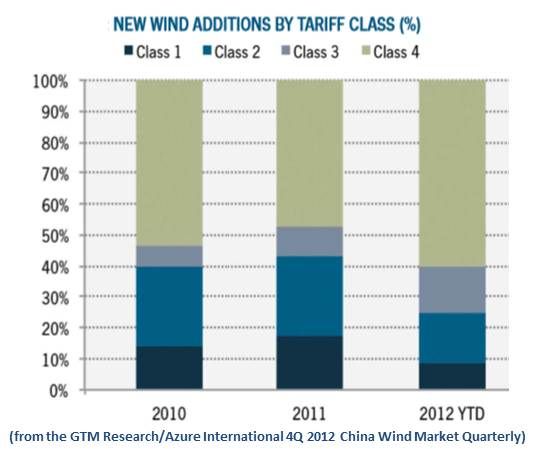The new GTM Research/Azure International China Wind Market Quarterly: 4th Quarter 2012 describes an important trend toward economic viability of harvesting lower speed winds: “In 2012, roughly 70 percent of new additions came in regions outside the top two tariff categories, compared to around 58 percent in 2011 and 61 percent in 2010.”
In 2009, the National Development and Reform Committee (NDRC) divided the national wind resource regions into four classes and established feed-in tariffs ranging from RMB 0.51 per kilowatt-hour in the windiest northern and northwestern regions to RMB 0.61 per kilowatt-hour in regions where the winds are weaker.
Developers initially went for the low-hanging fruit in the windy regions. Inner Mongolia now has almost 40 gigawatts of installed capacity, more than its peak electricity demand, and Hebei, and Gansu provinces each have over fifteen gigawatts. Some open sections of the countryside host so many multi-hundred megawatt projects they are known in China as wind bases.
But lack of transmission to regions with energy-hungry population centers, like Beijing and Shanghai, and excesses of wind power supply in less populated regions where demand lags, like Inner Mongolia and Gansu, have driven curtailment in those provinces to over 20 percent of their production.
In response, China’s developers have moved to provinces where transmission can deliver the electricity their projects generate despite the lower wind speeds there. The higher feed-in tariffs are undoubtedly some help, but new turbine technologies are the main reason the economic proposition works.
Taller turbines with longer blades and nacelles with smarter and more efficient generators and power electronics can turn winds that previously were too weak to generate useful amounts of power into economic harvests. In addition, the reduced wear-and-tear on turbines in low wind regimes improves the operations and maintenance and lifecycle propositions.
Shenhua is the leader in the trend toward development outside the six high-wind-speed provinces, both in cumulative and 2012 capacity. Guodian, Longyuan, and Datang follow.




